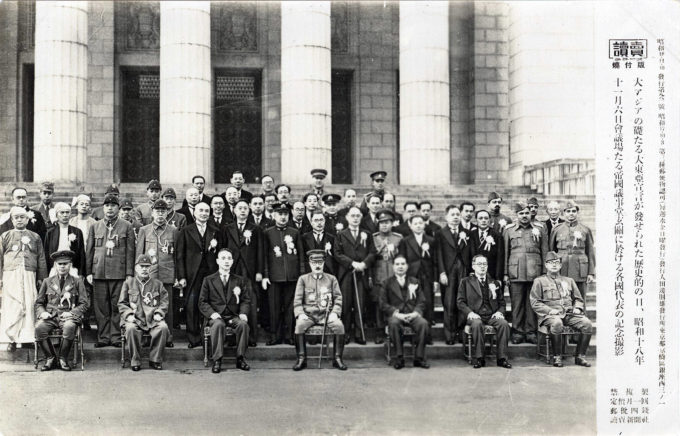
Great East Asia Conference, 1943. Japanese Prime Minister Gen. Tojo Hideki, host of the Greater East Asia Conference, is seated at center in this postcard image depicting the day (November 6) when the conference’s joint declaration was announced as the conferees sat in front of the Imperial Diet. The summit, held in Tokyo from Nov. 5-6, 1943, addressed few issues of substance, but was intended from the start as a propaganda show piece, to illustrate Japan’s commitments to the Pan-Asian ideal and to emphasize its role as the “liberator” of Asia from Western colonialism.
Pictured from left to right in the front row: Ba Maw (Burma), Zhang Jinghui (Prime Minister, Manchukuo), Wang Jingwei (“Reorganized National Government of the Republic of China”), Tōjō Hideki (Prime Minister, Japan), Wan Waithayakon (Thailand), Jose P. Laurel (“Second Philippine Republic”), and Subhas Chandra Bose (“Free India”).
See also:
“Greater East Asia Co-Prosperity Sphere” propaganda postcard, 1942.
“Patriotic March” (“Aikoku koshinkyoku”) propaganda postcard, c. 1942.
“[O]n Nov. 5 and Nov. 6, 1943, Japan hosted a meeting of Asian leaders in Tokyo, hub of the Greater East Asian Co-prosperity Sphere — the name it gave its wartime empire under the guise of Pan-Asian liberation.
“Certainly, the toppling of colonial governments in the region gave some credence to the notion that Japan was liberating Asia from the yoke of Western imperialism. However, the realities of Japanese subjugation soon sank in: It was a continuation of empire under new management.
“This historical gathering dubbed the Greater East Asia Conference included representatives from six nations: Japan, Thailand, Manchukuo (a puppet state of Japan carved off from northeast China and parts of Inner Mongolia in 1931), China (represented by the wartime Wang Jingwei government established by the Japanese in post-massacre Nanjing), the Philippines and Burma.
“Apart from Thailand, the other states represented there were viewed as being run by collaborators who owed their positions more to Japanese than domestic support. But collaboration was a careful calculation, aimed at trying to extract as much as possible from Japan while limiting the harm inflicted. It was also a survival strategy, as the kenpeitai (military police) dealt harshly with critics.
“Subhas Chandra Bose attended that Tokyo meeting as an observer representing the provisional government of Free India. Bose was easily the best-known figure there, and his presence lent the event perhaps more significance than it merited.
“… At the close of the conference, the delegates issued a document known as the Greater East Asia Declaration, which called for ‘the construction of an order of co-existence and co-prosperity, mutual support for autonomy and independence, and the abolition of racial discrimination.’
“Clearly a riposte to the Allied nations’ 1941 Atlantic Charter [between British Prime Minister Churchill and U.S. President Roosevelt], the Declaration offered a vision for Asia that challenged Western prerogatives and promises of a new post-World War II order.
“Japan’s call for the abolition of racial discrimination was a festering sore point as its 1919 proposal to include it in the covenant of the League of Nations was rejected by the then U.S. President Woodrow Wilson, who unilaterally overturned a majority vote in favor … In contrast, the 1941 Atlantic Charter neither included any renunciation of colonial rule, nor did it offer any promises of independence for colonized people.
“… And who was conspicuously missing from the party? Well, Indonesia, then constituting 60 percent of Southeast Asia’s population; Malaya; Indochina; and the Japanese colonies of Taiwan and Korea. Tokyo had secretly decided that Indonesia and Malaya would be retained as colonies; their natural resources trumped liberation rhetoric. So the bitter realities of the Greater East Asian Co-prosperity Sphere amply contradicted the lofty ideals.”
– Pan-Asian dreams: The Greater East Asia Conference, by Jeff Kingston, The Japan Times, Nov. 9, 2013

